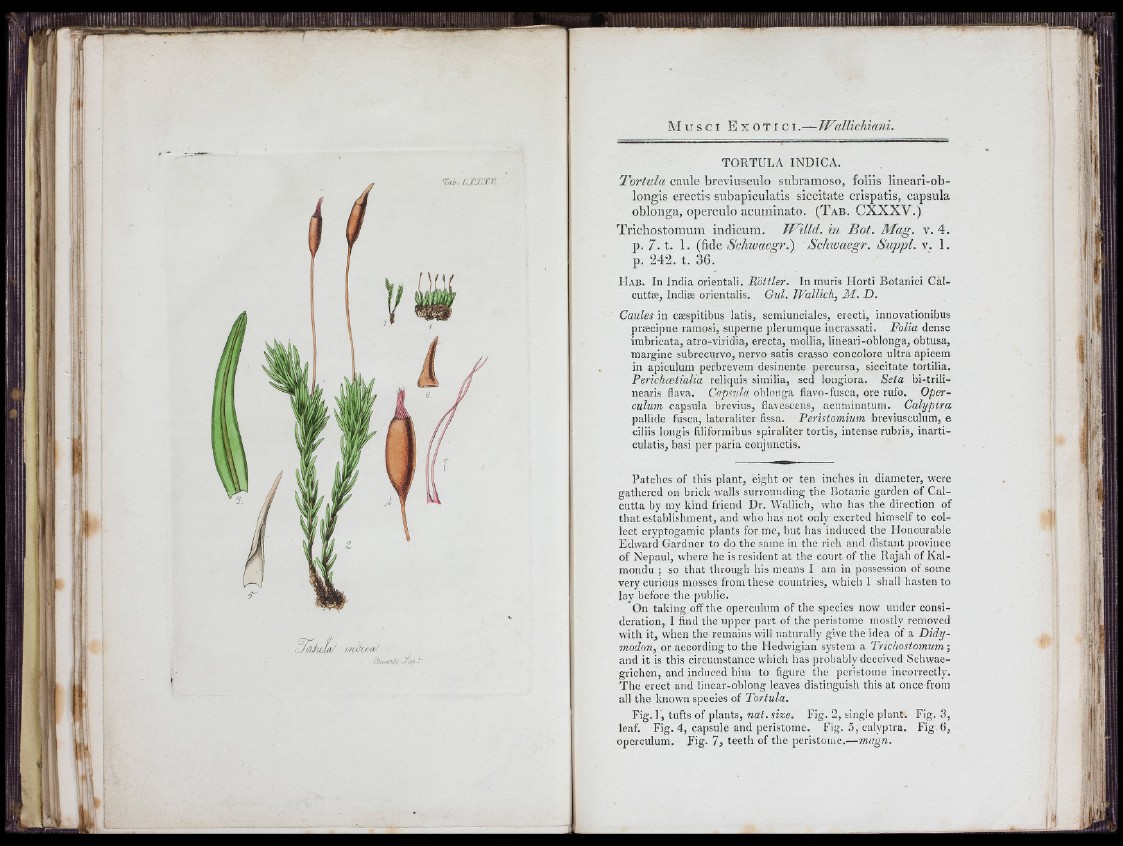
Á J iíijiJ jiJ im h w iJ .
fyiMí.i/h h
\ ;
M u s e i E xot i c i .— TVallichiani.
TORTULA INDICA.
Tortula caule breviusculo subramoso, foliis liueari-ob-
longis erectis subapiculatis siccitate crispatis, capsula
oblonga, operculo acuminato. (Tab. CXXXV.)
Trichostomum indicum. TVilld. i/i Bot. Mag. v. 4.
p. 7. t. 1. iflác Schiuaegr.') Schwaegr. Suppl. v. 1.
p . 242. t. 36.
H ab. In India orientali. Róttler. In mûris Horti Botanici Càl-
cuttæ, Indiæ orientalis. Gui. WalUch, M . D .
Caules in cæspitibus latis, semiunciales, erecti, innovationibus
præcipue ramosi, superne plerumque incrassati. Folia dense
imbricata, atro-viridia, erecta, niollia, lineari-oblonga, obtusa,
margine subrecurvo, nervo satis crasso concolore ultra apicem
in apiculum perbrevem desinente percursa, siccitate tortilia.
Perichætialia reliquis similia, sed longiora. Seta bi-trili-
nearis flava. Capsula oblonga flavo-fusca, ore rufo. Operculum
capsula brevius, flavescens, acurniuatum. Calyptra
pallide fusca, lateraliter fissa. Peristomium breviusculum, e
ciliis longis filiformibus spiraliter tortis, intense rubris, inarti-
culatis, basi per paria conjunctis.
Patches of this plant, eight or ten inches in diameter, were
gathered on brick walls surroiiiicling the Botanic garden of Calcutta
by my kind friend Dr. Wallich, who has the direction of
that establishment, and who has not only exerted himself to collect
cryptogamic plants for me, but lias induced the Honourable
Edward Gardner to do the same in the rich and distant province
of Nepaul, where he is resident at the court of the Rajah of Kal-
mondu ; so that through his means I am in possession of some
very curious mosses from these countries, which 1 shall hasten to
lay before the public.
On taking off the operculum of the species now under consideration,
I find the upper part of the peristome mostly removed
with it, when the remains will naturally give the idea ot a Didy-
modon, or according to the Hedwigian system a Trwhostomum ;
and it is this circumstance which has probably deceived Schwaegrichen,
and induced him to figure tlie peristome incorrectly.
The erect and linear-oblong leaves distinguish this at once from
all the known species of Tortula.
Fig. 1, tufts of plants, nat. size. Fig. 2, single plant. Fig. S,
leaf. Fig. 4, capsule and peristome. Fig. 5, calyptra. Fig. 6,
operculum. Fig- 1, teeth of the peristome.—magn.